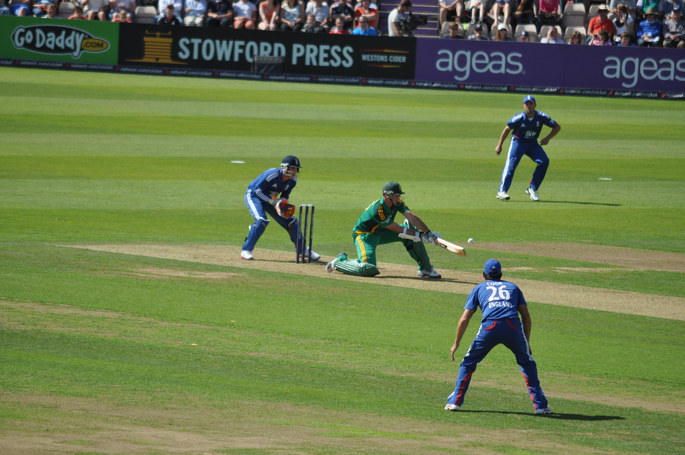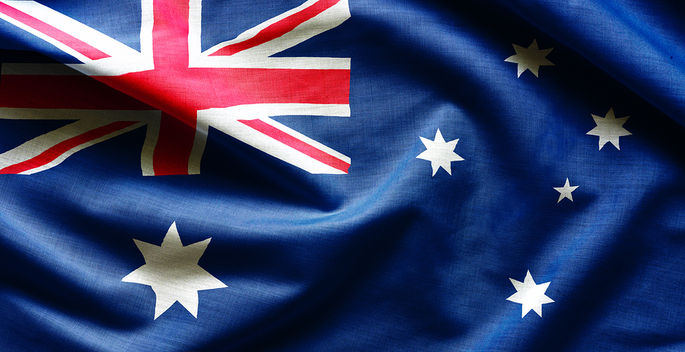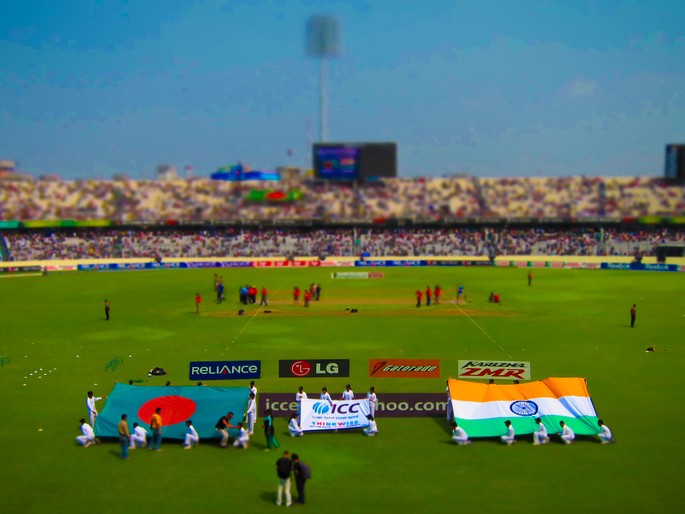Fast Facts
- When: 5th October to 19th November 2023
- Where: India (Various Grounds)
- Watch: Sky Sports
- Official Website: ICC Cricket World Cup
The ICC Cricket World Cup, much like the FIFA World Cup, is held every four years by a host nation which rotates amongst the major cricketing nations.
The tournament organisers are the International Cricket Council and the matches come in the form of One Day Internationals or ODIs. These are where both sides in a match play a maximum of 50 overs each, meaning games start and finish the same day.
The 2023 Cricket World Cup is the 13th running of the tournament and is being held between October and November in India with the final taking place at the Narendra Modi Stadium in Ahmedabad.
Existing Customer Free Bets & Money Back Offers
Please Note: This event has now ended.
2023 Cricket World Cup Group Matches
| Team | Opponent (Date) | ||
|---|---|---|---|
| England | New Zealand (5th Oct) | Bangladesh (10th Oct) | Afghanistan (15th Oct) |
| South Africa (21st Oct) | Sri Lanka (26th Oct) | India (29th Oct) | |
| Australia (4th Nov) | Netherlands (8th Nov) | Pakistan (11th Nov) | |
| Afghanistan | Bangladesh (7th Oct) | India (11th Oct) | England (15th Oct) |
| New Zealand (18th Oct) | Pakistan (23rd Oct) | Sri Lanka (30th Oct) | |
| Netherlands (3rd Nov) | Australia (7th Nov) | South Africa (10th Nov) | |
| Australia | India (8th Oct) | South Africa (12th Oct) | Sri Lanka (16th Oct) |
| Pakistan (20th Oct) | Netherlands (25th Oct) | New Zealand (28th Oct) | |
| England (4th Nov) | Afghanistan (7th Nov) | Bangladesh (11th Nov) | |
| Bangladesh | Afghanistan (7th Oct) | England (10th Oct) | New Zealand (13th Oct) |
| India (19th Oct) | South Africa (24th Oct) | Netherlands (28th Oct) | |
| Pakistan (31st Oct) | Sri Lanka (6th Nov) | Australia (11th Nov) | |
| India | Australia (8th Oct) | Afghanistan (11th Oct) | Pakistan (14th Oct) |
| Bangladesh (19th Oct) | New Zealand (22nd Oct) | England (29th Oct) | |
| Sri Lanka (2nd Nov) | South Africa (5th Nov) | Netherlands (12th Oct) | |
| Netherlands | Pakistan (6th Oct) | New Zealand (9th Oct) | South Africa (17th Oct) |
| Sri Lanka (21st Oct) | Australia (25th Oct) | Bangladesh (28th Oct) | |
| Afghanistan (3rd Nov) | England (8th Nov) | India (12th Nov) | |
| New Zealand | England (5th Oct) | Netherlands (9th Oct) | Bangladesh (13th Oct) |
| Afghanistan (18th Oct) | India (22nd Oct) | Australia (28th Oct) | |
| South Africa (1st Nov) | Pakistan (4th Nov) | Sri Lanka (9th Nov) | |
| Pakistan | Netherlands (6th Oct) | Sri Lanka (10th Oct) | India (14th Oct) |
| Australia (20th Oct) | Afghanistan (23rd Oct) | South Africa (27th Oct) | |
| Bangladesh (31st Oct) | New Zealand (4th Nov) | England (11th Nov) | |
| South Africa | Sri Lanka (7th Oct) | Australia (12th Oct) | Netherlands (17th Oct) |
| England (21st Oct) | Bangladesh (24th Oct) | Pakistan (27th Oct) | |
| New Zealand (1st Nov) | India (5th Nov) | Afghanistan (10th Nov) | |
| Sri Lanka | South Africa (7th Oct) | Pakistan (10th Oct) | Australia (16th Oct) |
| Netherlands (21st Oct) | England (26th Oct) | Afghanistan (30th Oct) | |
| India (2nd Nov) | Bangladesh (6th Nov) | New Zealand (9th Nov) | |
About The Cricket World Cup

Ask an Englishman or an Aussie what the most important cricketing contest is and they’ll invariably tell you that it’s the Ashes. Whilst that’s one of the most thrilling and competitive match-ups in all of sport that the rest of the world is likely to take an interest in, it’s not one that cricket fans from South Africa, India or even Scotland will have an emotional engagement in. It’s the cricketing equivalent of the Champions League final in football for supporters of teams that don’t have any say in the game; fun to watch but ultimately irrelevant to their own success.
In that sense, the Cricket World Cup is, as the name suggests, far more of a global event that cricket fans from all four corners of the world get involved with. It also differs from the Ashes in the sense that it is a set of one day international matches rather than full test matches. Organised by the International Cricket Council and taking place every four years, it is a flagship event in the sport. It’s also important to draw a distinction between this event and the Women’s Cricket World Cup, which actually preceded the men’s event and took place for the first time in 1973 as opposed to 1975.
The History International Cricket

In order to understand why the Cricket World Cup became a going concern in the sport you first need to understand the development of international cricket in general. Despite being created in England and quickly moved around the empire, the first cricket match to take place between two nations was one between the United States of America and Canada in September of 1844. Despite this, the first test match of note didn’t occur for another thirty-three years but did see the start of something special as it was between England and Australia.
The two nations regularly competed against each other and when the Aussies won at The Oval in 1882 a British newspaper called The Sporting Times published an obituary that stated that ‘the body [of English cricket] will be cremated and the ashes taken to Australia’. When England travelled to Australia the following year the captain said that there were heading there to ‘regain those ashes’ and the term has been used to described the matchup between the two nations ever since. Other nations soon gained test status, with South Africa being one of the first to do so in 1889.
When cricket was added to the Olympic roster in 1900 it was because more and more countries had started to take the game seriously, with France losing to England in the gold medal match. Whilst this was the only occasion that cricket has been played during the Summer Olympics, the sport’s prestige had already been written. By 1912 the desire for the numerous nations that saw cricket as one of its key sports to play against each other in a competitive series grew to such an extent that the Triangular Tournament was formed. It only involved the three Test nations at the time, namely England, Australia and South Africa, but it proved the desire to see competitive cricket take place.
Unfortunately the poor weather of that summer meant that it was something of a failure and future tournaments were mostly bilateral in nature rather than the multilateral nature of that event. As the years passed, more and more nations began to play Test cricket, with the likes of the West Indies, New Zealand and India being added to the Test roster. That in and of itself wasn’t enough to bring about the introduction of any sort of mass competition between the nations, if for no other reason than the 1912 version was considered to be such a resounding failure. Added to that was the length of time needed for a Test match to take place, meaning that tournaments involving numerous different teams would have been impossible to organise.
The Invention of One Day Cricket

One of the key components to the advent of a multi-nation tournament was the creation of One Day matches during the 1960s. It began life in the world of English county cricket, where a way of attracting lager crowds was created to keep the format of the sport alive. The first such example came in 1962 with the Midlands Knock-Out Cup, quickly being followed by the Gillette Cup the year after. It proved to be a popular way of watching the sport to such an extent that a Sunday League for one day cricket was created in 1969.
As with most things in life, when something works on one level then soon enough other levels take them to heart. That’s what happened in 1971 when a Test between Australia and England in Melbourne was abandoned because of poor weather and so the fifth day was used to play an international one day match. The idea was to entertain the crowd and give them at least some consolation for not being able to see the Test itself. It was played over forty overs and involved eight balls per over.
The Inaugural World Cup: England, 1975
The success of the One Day format in English county cricket and the fact that it had been well received by the crowd in Melbourne slowly began to persuade the International Cricket Council that a World Cup played in that format might be a good idea. For that reason, they organised the first such event in England in 1975, starting on the seventh of June. The competition was sponsored by Prudential plc and consisted of sixty overs per team, with six balls in each over.
The event welcomed teams from Australia, New Zealand, India, the West Indies, Pakistan, Sri Lanka and, of course, England, plus a composite East African team. South Africa were the most obvious absentee, having been banned from taking part in international cricket because of their policy of apartheid.
Cricket World Cup 1975 Groups
| Position | Group A | Group B |
|---|---|---|
| 1st | England | West Indies |
| 2nd | New Zealand | Australia |
| 3rd | India | Pakistan |
| 4th | East Africa | Sri Lanka |
Unlike later variations of the One Day tournament, the event asked the cricketers to wear the standard white outfits and the usual red cricket ball. The final took place at Lord’s and saw Australia lose out to the West Indies by seventeen runs.
World Series Cricket Leads to World Cup Overhaul

Towards the end of the 1970s an Australian media tycoon named Kerry Packer decided to set up a rival event to the Cricket World Cup, which he named World Series Cricket. His idea was to liven up the game in a manner that was reflective of the new, exciting nature of One Day Internationals. His manner of doing this was to get the players to wear brighter and more vibrant colours than the traditional all-white outfits, also seeing the games played exclusively at night under floodlights using a white ball and introducing dark sight screens. Because it was broadcast on television, he also brought in multiple camera angles, microphones to capture player sounds and graphics on the screens around the ground.
Despite the general popularity of the event, which was hosted again in 1979 before becoming the World Series Cup, the ICC resisted the urge to follow in the WSC’s footsteps and introduce such frivolities. Eventually, though, calls to do so grew too great and so when the 1992 Cricket World Cup rolled around a lot of those elements were introduced. Hosted by New Zealand and Australia, coloured clothing, day into night games and white balls were all introduced for the first time. It also saw the introduction of the South African team to the event for the first time, thanks to the end of the apartheid regime in the country. Despite starting the tournament poorly, Pakistan caused yet more upset for England by beating them in the final by twenty-two runs.
The Aussies’ World Cup Dominance

England had long been used to the tough cricketing battle that the Australians put forward, having regularly contested the Ashes with them. It’s perhaps somewhat fitting, therefore, that the 1999 tournament was hosted by predominantly by England as Australia began to assert their dominance over the competition. With matches also held in Scotland, Wales, Ireland and even the Netherlands, the Aussies made it to the final where they faced a team from Pakistan that they dismissed for 132. They then smashed that target themselves in fewer than twenty overs, leaving themselves with eight wickets in hand.
It was another jointly-hosted tournament in 2003, when Kenya, Zimbabwe and South Africa shared the honour. This time it was India that they needed to beat in the final and they managed to achieve an unassailable lead of 359 runs for just two wickets before defeating their opponents by 125 runs. The 2007 tournament saw hosting duties move to the West Indies and the tournament expanded to include sixteen teams. One of those was Ireland, who beat Pakistan during the group stage. Sri Lanka were Australia’s final opponents this time, with appalling light conditions being the story of the day. The Aussies dealt with the issues that were thrown up, however, and win by 53 runs.
Australia’s stranglehold on the World Cup was finally broken in 2011 when they were knocked out in the quarter-finals by eventual winners India. The Aussies didn’t have to wait too long to get their hands on the trophy again however. The 2015 tournament was co-hosted by Australia and New Zealand with the final held at the Melbourne Cricket Ground. New Zealand won the toss and elected to bat but were skittled out for just 183 runs, a total that Australia reached in under 34 overs to become World Champions for a fifth time.
Four years later Australia were again beaten by the eventual winners after losing to England by eight wickets in semi-final at Edgbaston in 2019. In 2023, Australia’s tournament got off to a stuttering start. A six wicket defeat to hosts India was followed up by a 134 run loss to South Africa. Despite losing both opening games, Australia won all seven of their remaining matches to qualify for the semi-finals where they would meet South Africa, turning the tables from their earlier defeat to win by three wickets. The odds were again against the Aussies in the final where they met home favourites India in Ahmedabad. Australia won the toss and wisely put their opponents in to bat, where they reduced the free scoring India team to 240 runs. They reached this total with seven overs to spare to win a sixth World Cup and a fifth in seven tournaments.
Hosting The Cricket World Cup

India and Bangladesh hosted the 2011 Cricket World Cup alongside Sri Lanka. Photo by rushdi13, flickr
During the Cricket World Cup’s more formative years, only England had the infrastructure to be able to host the tournament. For that reason the English hosted the matches in 1975, when the West Indies beat Australia in the final, 1979, when the West Indies defended their title against the hosts, and 1983, when India became the first team to take the title away from the Windies by beating them in the final. The 1983 tournament also involved matches played in Wales, but England were the sole designated hosts of the competition that year.
The first time that the World Cup moved out of England came in 1987, at which point India and Pakistan were elected to jointly host the tournament. It was also the first time that two nations officially shared hosting duties. The competition’s format also changed for the 1987 iteration, with games reduced from sixty overs per innings to fifty, which was due to the fact that there was less daylight in the Indian subcontinent than during the summer in England. It also saw Australia win the event by a then-record number of runs, beating England by just seven.
Winning Hosts
Prior to 2011, the only time that a host nation had won the Cricket World Cup had occurred in 1996 when Pakistan, India and Sri Lanka played host and the latter beat Australia by seven runs in the final to lift the trophy. Then, when 2011 rolled around, it started a series of the host nation or joint-host nation winning the competition on consecutive occasions. The first victory fell to India when they faced co-hosts Sri Lanka in the final, winning by six wickets. Pakistan were meant to be co-hosts of the tournament but had the duties taken away from them because the Sri Lankan cricket team had been the victims of a terrorist attack in 2009.
The 2015 Cricket World Cup saw hosting duties once again shared, this time between Australia and New Zealand. Australia, who saw a winning streak of thirty-five matches in the competition brought to a close when they lost their last group stage match against Pakistan in the 2011 tournament, once again made it all the way to the final in 2015. It was the second successive final where two joint-hosts ended up facing each other, this time with the Aussies beating their neighbours by seven wickets in the final that was hosted in Melbourne. Just as India had won in Mumbai four years earlier, Australia won it in Melbourne to become just the second team to win the World Cup in a final on home soil.
England made it three successive winning World Cup hosts when they edged out New Zealand at Lord’s to win their first title in 2019. India came close to continuing this trend in 2023, reaching the final only to lose out to Australia.
How the Hosts Are Chosen
The final thing worth drawing your attention to is the manner in which a host nation is chosen by the International Cricket Council. Nations make bids for the right to do so, which are then looked at and scrutinised by the ICC’s executive committee. They cast votes on which of the nations have made the most attractive bid, awarding the right to host the World Cup to them.
Once the tournament left England for the shores of India and Pakistan in 1987, the majority of Cricket World Cups have been jointly hosted by nations that are located close to each other geographically. The likes of South Asian countries in 1987, 1996 and 2011 and the Australasian pair in 1992 and 2015 are good examples of this.
Tournament Format

Nations that play Test cricket automatically qualify for the main event of the Cricket World Cup, but there’s a qualifying tournament for nations that aren’t so lucky. A new format for this qualification phase was introduced ahead of the 2015 iteration of the competition. Automatic qualifying berths go to the two teams that finish in the top two during the ICC World Cricket League Championship.
The rest of the teams as well as the teams that finished third and fourth in the ICC World Cricket League Division Two and the top two teams of Division Three then go into the World Cup Qualifier to fight it out for the two remaining spaces at the World Cup. Obviously the exact numbers of teams that are able to make it into the World Cup Qualifier changes from year to year, so if you’re not too sure then it’s best to check the qualification criteria for the year in which you’re looking at.
Once the number and make-up of the participating teams has been decided, the World Cup itself follows a specific format. The format used today is markedly different from the one used in the past and it’s likely to change again in the future.
For the 2023 World Cup the number of participating teams was set at ten, with all of the teams playing against each other once in a round-robin style tournament. The top four teams at the end of this section of the competition will move forward to the semi-finals, with the winning teams from that stage moving forward to the final. The winners of the final will be declared to be the World Champions.
Interesting Facts
The trophy presented to the winners of the Cricket World Cup is a golden globe, which is supported by three columns made from silver. The columns are shaped to look like stumps with bails at the top. There are three of them to represent the three fundamentals of cricket: fielding, bowling and batting.
Other facts that you might enjoy are:
- The Cricket World Cup is one of the most viewed sporting events in the world
- The hosts or partial hosts only won the tournament four times between 1975 and 2023
- With 2,278 runs, Sachin Tendulkar racked up more runs than any other batter during the World Cup between 1992 and 2011
- Tendulkar was also the player who held the record for most runs in a single tournament between 1975 and 2019, scoring 673 in 2003, this was smashed by Virat Kohli in 2023 when he recorded 765 runs
- Glenn McGrath is the bowling record holder, taking 71 wickets between 1996 and 2007
